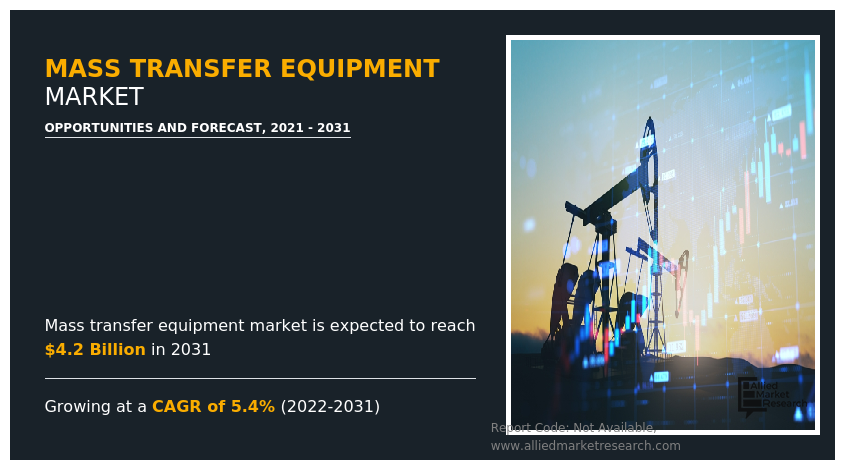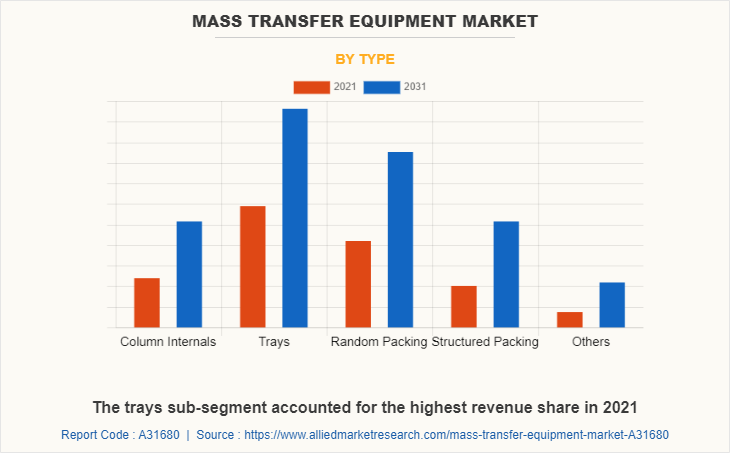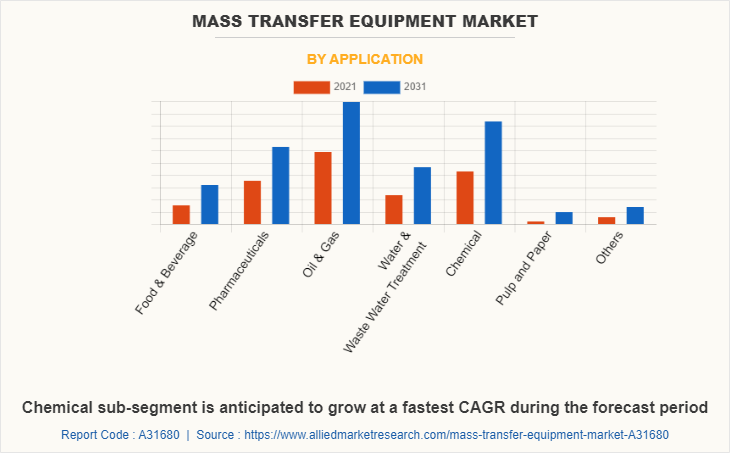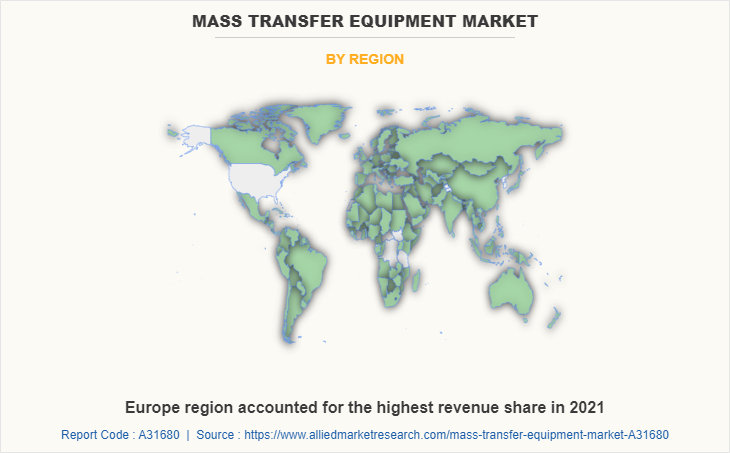Mass Transfer Equipment Market Research, 2031
The global mass transfer equipment market was valued at $2.5 billion in 2021, and is projected to reach $4.2 billion by 2031, growing at a CAGR of 5.4% from 2022 to 2031. Mass transfer equipment is widely used across various industries such as food & beverage, chemicals, and others. For instance, in food & beverage industry, mass transfer equipment is used for the physical separation of components from solid or liquids, for removal of undesirable nonfood components, or for recovering essential food products.

One of the primary factors driving the significant expansion of mass transfer equipment sales is an increase in demand for sustainable and creative mass transfer equipment solutions for crucial operations in several sectors. For instance, the mass transfer equipment namely gas-liquid contacting equipment includes spray columns, tray/plate columns, agitated vessels, bubble columns, packed columns, and others. Recent advancements, as well as significant investment in cost-effective and efficient mass transfer technologies, are expected to fuel demand for the global market. Furthermore, the design of this mass transfer equipment provides clean liquid disengagement, low-pressure loss, and improved vapor dispersion. These factors are anticipated to boost the mass transfer equipment demand in the coming years.
Growing concerns over environmental pollution associated with the manufacturing of mass transfer equipment is estimated to restrain the market growth. The traditional mass transfer equipment has certain limitations such as weeping, flooding, channeling, and others which is estimated to hamper the mass transfer equipment market demand. In addition, the high cost of the mass transfer equipment is anticipated to restrain the market growth in the upcoming years.
Growing industrial applications of mass transfer equipment in the industrial sector to generate excellent growth opportunities. For instance, in the industrial sector, these equipments are used for crude distillation, acid gas removal, production of olefins ammonia production, carbon capture technologies, aromatics, ethylene glycol production, and others. Furthermore, the graphite mass transfer equipment market has a wide range of uses in the chemicals and pharmaceutical sector for corrosive applications. In the chemical industry, the mass transfer equipment demand is growing rapidly owing to its applications in heat transfer engineering, separations engineering, reaction engineering, and others. All these factors are anticipated to boost the mass transfer equipment market growth in the upcoming years.
The key players profiled in this report include Sulzer Ltd, Koch Engineered Solutions., Beijing Zehua Chemical Engineering Co., Ltd., Finepac Structures Pvt. Ltd., DtEC, MTE Group, Munters Group, Baretti, Tianjin Univtech Co., Ltd., and HAT International Ltd.
The global mass transfer equipment market is segmented on the basis of type, application, and region. By type, the market is sub-segmented into column internals, trays, random packing, structured packing, and others. By application, the market is classified into food & beverages, pharmaceuticals, oil & gas, water & waste water treatment, chemical, pulp and paper, and others. By region, the market is analyzed across North America, Europe, Asia-Pacific, and LAMEA.
The mass transfer equipment market is segmented into Type and Application.

By type, the trays sub-segment dominated the market in 2021. The trays sub-segment is expected to have a significant market share during the study period due to their beneficial uses in mass transfer stages and efficiency, and they are mostly employed as splitters in petrochemical and aromatic applications. Furthermore, active area developments and sophisticated technologies are expected to drive sub-segment growth by 2031. The mass transfer equipment has application in oil refineries for distillation purpose. These trays can operate under partial vacuum, under atmospheric, or complete vacuum conditions. These are predicted to be the major factors affecting the mass transfer equipment market size during the forecast period.

By application, the oil & gas sub-segment dominated the global mass transfer equipment market share in 2021. Oil & gas mass transfer in wastewater treatment techniques has received considerable attention in recent years from both business and academics. Without a doubt, advances in modelling oil & gas mass transfer can provide several benefits in terms of acid-base equilibria, reaction rates, plant energy expenditure, and greenhouse gas emissions.

By region, Europe dominated the global market in 2021 and is projected to remain the fastest-growing sub-segment during the forecast period. The demand in countries, namely Germany and France, is growing rapidly as it is a clean fuel and alternative to oil & gas-based. Established mass transfer equipment companies are primarily concentrating on strengthening their current product lines and increasing profitability through operational excellence, which will fuel the expansion of the European market.
Impact of COVID-19 on the Global Mass Transfer Equipment Industry
- COVID-19 has negatively impacted various industries such as chemical and petrochemical which has led to a drastic decline in petrochemical sales. As mass transfer equipment is widely used in chemical and petrochemical manufacturing, there was a significant reduction in mass transfer equipment demand globally.
- China is the leading producer and exporter of application such as chemicals required for mass transfer equipment production. However, China being the epicenter of the coronavirus pandemic, its export was affected, leading to a decline in mass transfer equipment production.
- Sales of mass transfer equipment are directly proportional to the demand from applications namely food & beverage, chemicals, pharmaceuticals, oil & gas, and others. However, the demand for mass transfer equipment in the chemicals industry was greatly affected owing to import-export restrictions, closed borders, and supply chain disruptions due to the outbreak of the COVID-19 pandemic.
Key Benefits For Stakeholders
- The report provides an exclusive and comprehensive analysis of the global mass transfer equipment market trends along with the mass transfer equipment market forecast
- The report elucidates the mass transfer equipment market opportunity along with key drivers, and restraints of the market. It is a compilation of detailed information, inputs from industry participants and industry experts across the value chain, and quantitative and qualitative assessment by industry analysts
- Porter’s five forces analysis helps analyze the potential of the buyers & suppliers and the competitive scenario of the market for strategy building
- The report entailing the mass transfer equipment market analysis maps the qualitative sway of various industry factors on market segments as well as geographies
- The data in this report aims on market dynamics, trends, and developments affecting the mass transfer equipment market opportunities
Mass Transfer Equipment Market Report Highlights
| Aspects | Details |
| Market Size By 2031 | USD 4.2 billion |
| Growth Rate | CAGR of 5.4% |
| Forecast period | 2021 - 2031 |
| Report Pages | 305 |
| By Type |
|
| By Application |
|
| By Region |
|
| Key Market Players | baretti mefe, HAT International Ltd., Sulzer Ltd, Munters Group, Tianjin Univtech Co., Ltd., Koch-Glitsch., MTE Group., Dtec, Beijing Zehua Chemical Engineering Co., Ltd., Finepac Structures Pvt. Ltd. |
Analyst Review
The significant expansion of the mass transfer equipment market is majorly owing to rise in the demand for sustainable and creative mass transfer equipment solutions for crucial operations in several sectors. In addition, the implementation of stringent government regulations toward environmental pollution, owing to the use of gas & oil, diesel, or pulp and paper is expected to boost the market growth during the forecast period. For instance, gas-liquid mass transfer technology is extremely important in wastewater treatment procedures. Improvements in gas-liquid mass transfer models can give significant benefits in areas such as plant energy consumption, reaction rates, greenhouse gas emissions, and acid-base equilibria. Asian nations are facing various water management difficulties, including groundwater shortages, higher cost associated with drinking water production, and inadequate re-use, collection, and treatment of wastewater outside of urban areas.
Among the analyzed regions, Europe is expected to account for the highest revenue in the market by the end of 2031, followed by Asia-Pacific, North America, and LAMEA. Established enterprises of mass transfer equipment are mainly focusing on strengthening existing portfolios and driving profitability through operational excellence, which will drive the growth of European market.
The diverse applications of mass transfer equipment across chemical, food & beverage, pharmaceuticals, oil & gas, and other sectors is the major market driver. For instance, the use of mass transfer equipment in the food & beverage sector helps in maintaining food safety & quality, which helps in reducing food wastage, helps in minimizing foodborne diseases, and extends the shelf life of food products.
Some of the leading applications of the mass transfer equipment market include separations engineering, reaction engineering, heat transfer engineering, and many others.
Europe is the largest regional market for the mass transfer equipment market.
The mass transfer equipment market is estimated to reach $14.1 billion by 2031.
Some of the leading companies to hold the highest market share in mass transfer equipment include Sulzer Ltd, Koch Engineered Solutions., Beijing Zehua Chemical Engineering Co., Ltd., and Finepac Structures Pvt. Ltd.
Loading Table Of Content...



